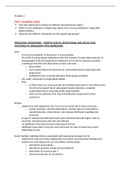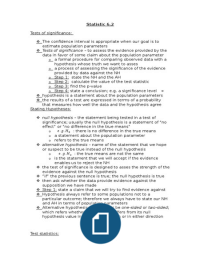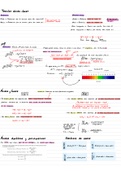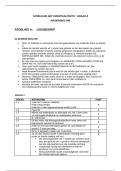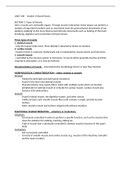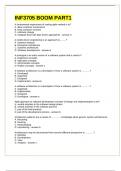Problem 2
PART 1 LEARNING GOALS
How does depression manifest at different developmental stages?
What are the challenges in diagnosing depression in young individuals? (especially
babies/infants)
What are the different treatments for the specific age groups?
FERGUSSON, WOODWARD – MENTAL HEALTH, EDUCATIONAL AND SOCIAL ROLE
OUTCOMES OF ADOLESCENT WITH DEPRESSION
Intro
- increased recognition of depression in young people
- 2% to 8% of young people experience their first episode of major depression by 16
- young people with early depressive tendencies are at risk for adverse outcomes
- 3 pathways that link early depression to later outcomes
o direct effect
o non-causal (reflects the presence of confounding factors associated with
depression)
o mediated by the comorbid disorders (intervening variables)
- this study: examined 21 longitudinal studies
- RQs:
o to what extent are young people who develop depression in mid adolescence
(14-16) at increased risk of subsequent mental disorders, academic
underachievement, and reduced life opportunities?
o what are the pathways that may link adolescent depression to later
outcomes?
Results
- adolescents with depression (16-21) are at increased risk of many outcomes:
o anxiety disorders, nicotine dependence, alcohol abuse or dependence,
suicidal behavior, school failure, and reduced likelihood of getting into
university
- at age 21, adolescents with depression were characterized with higher rates of
recurrent unemployment and early parenthood
- no significant interaction between depression and sex
- significant main effect of sex for most outcomes (so rates of outcomes varied
depending on sex)
Social, familial, individual factors associated with depression between 14-16
- adolescents with and without depression had similar socioeconomic backgrounds
- adolescents with depression are more likely (confounding):
o exposed to sexual abuse
o exposed to parental change during childhood
o have lower IQ scores at age 9
o showed tendencies of neuroticism
, o showed tendency to be raised by an educationally underachieved mother
o reported higher rates of deviant peer involvement in adolescence
o higher rates of comorbid anxiety disorders, conduct disorders, and alcohol
abuse
o to smoke cigarettes
Adjusted for confounding factors and comorbid disorders
- evidence of clear continuity from adolescent depression to later depression
- !!!associations between depression and outcomes (nicotine dependence, alcohol
abuse and dependence, suicide attempt, educational underachievement,
unemployment, and early parenthood) were explained by confounding factors
(parental change, childhood sexual abuse, IQ, neuroticism, involvement with deviant
peers, maternal educational underachievement)
- controlling comorbid disorders did not change the depression-outcome associations
Discussion
- evidence of a direct pathway in which adolescent depression is a precursor of long-
term depression and anxiety
- relationship between depression and other outcomes appear to be non-causal
social, familial and personal factors that were associated with an increased risk of
adolescent depression were associated with increased risk of late adverse outcomes
- clinical implications:
o adolescent depressive disorders are recurrent
o importance of placing an early episode of depression within the context of a
young person’s life history and social and personal circumstances
ZHOU ET AL. – COMPARATIVE EFFICACY AND ACCEPTABILITY OF ANTIDEPRESSANTS,
PSYCHOTHERAPIES AND THEIR COMBINATION FOR ACUTE TREATMENT OF CHILDREN AND
ADOLESCENTS WITH DEPRESSIVE DISORDER
Intro
- in 2017, MDD in children and adolescents was 0.3% between 5-10, 2.7% between 11-
16 and 4.8% between 17-19
- pharmacological and psychological interventions are widely used
- psychotherapy is often recommended as first-line intervention, and antidepressants
are reserved for more severe illnesses
- not enough evidence to establish which one and whether combination is better
- this study: comprehensive systematic review of all available RCTs to compare any
active interventions (antidepressants, psychotherapy and combination)
Method
- 71 RCTs included in the meta-analysis
- included placebo-controlled and head-to-head trials of 16 antidepressants, 7
psychotherapies, and 5 combinations (at least 4 weeks and >10 patients)
- primary outcomes were efficacy (change in depressive symptoms) and acceptability
(treatment discontinuation)
, - secondary outcome was suicidality
- meta-regression to determine whether the results were affected by study
characteristics: sex ratio, mean age, sponsorship, treatment duration, comorbid
psychiatric disorder, risk of bias, sample size, rating scale, publication year, and
baseline severity
- 32 trials were high, 32 were moderate and 7 were low risk of bias
Results
- efficacy:
o only fluoxetine+CBT and fluoxetine were more effective than pill placebo or
psychological controls
o no pharmacotherapy was more effective than psychotherapy alone
o Fluoxetine+CBT was more effective than CBT and psychodynamic therapy
o interpersonal psychotherapy was more effective than all psychological
controls
o nortriptyline and waiting list were worse than most active interventions
- acceptability:
o nefazodone and fluoxetine had fewer dropouts than sertraline, imipramine,
and desipramine
o imipramine had more dropouts than pill control and desvenlafaxine,
fluoxetine+CBT and vilazodone
- suicidality:
o venlafaxine was associated with an increased risk of suicidal behavior
- studies with higher baseline severity were associated with larger treatment effects
- studies with higher risk of bias were associated with a lower drop-out rate
- most of the results were rated as low to very low in terms of confidence of evidence!
Discussion
- fluoxetine (alone or in combination with CBT) might be considered the best option to
treat acute symptoms in children and adolescents with MDD
- these findings contract previous findings (in which all antidepressants were more
effective than pill placebo and all psychotherapy interventions) several
explanations:
o differences in biological, cognitive and social development in adolescents
might modify the impact of treatments
e.g. hormones could worsen emotional responses to negative social
stimuli by dysregulating HPA axis
o small number of trials and smaller sample sizes for young patients decrease
statistical power to make meaningful comparisons
o different design methods lead to higher placebo responses in young patients
which hinder the detection of positive results
o psychotherapies used for young patients are adaptations of adult treatments,
not suited to cognitive, behavioral and emotional characteristics of young
patients
PART 1 LEARNING GOALS
How does depression manifest at different developmental stages?
What are the challenges in diagnosing depression in young individuals? (especially
babies/infants)
What are the different treatments for the specific age groups?
FERGUSSON, WOODWARD – MENTAL HEALTH, EDUCATIONAL AND SOCIAL ROLE
OUTCOMES OF ADOLESCENT WITH DEPRESSION
Intro
- increased recognition of depression in young people
- 2% to 8% of young people experience their first episode of major depression by 16
- young people with early depressive tendencies are at risk for adverse outcomes
- 3 pathways that link early depression to later outcomes
o direct effect
o non-causal (reflects the presence of confounding factors associated with
depression)
o mediated by the comorbid disorders (intervening variables)
- this study: examined 21 longitudinal studies
- RQs:
o to what extent are young people who develop depression in mid adolescence
(14-16) at increased risk of subsequent mental disorders, academic
underachievement, and reduced life opportunities?
o what are the pathways that may link adolescent depression to later
outcomes?
Results
- adolescents with depression (16-21) are at increased risk of many outcomes:
o anxiety disorders, nicotine dependence, alcohol abuse or dependence,
suicidal behavior, school failure, and reduced likelihood of getting into
university
- at age 21, adolescents with depression were characterized with higher rates of
recurrent unemployment and early parenthood
- no significant interaction between depression and sex
- significant main effect of sex for most outcomes (so rates of outcomes varied
depending on sex)
Social, familial, individual factors associated with depression between 14-16
- adolescents with and without depression had similar socioeconomic backgrounds
- adolescents with depression are more likely (confounding):
o exposed to sexual abuse
o exposed to parental change during childhood
o have lower IQ scores at age 9
o showed tendencies of neuroticism
, o showed tendency to be raised by an educationally underachieved mother
o reported higher rates of deviant peer involvement in adolescence
o higher rates of comorbid anxiety disorders, conduct disorders, and alcohol
abuse
o to smoke cigarettes
Adjusted for confounding factors and comorbid disorders
- evidence of clear continuity from adolescent depression to later depression
- !!!associations between depression and outcomes (nicotine dependence, alcohol
abuse and dependence, suicide attempt, educational underachievement,
unemployment, and early parenthood) were explained by confounding factors
(parental change, childhood sexual abuse, IQ, neuroticism, involvement with deviant
peers, maternal educational underachievement)
- controlling comorbid disorders did not change the depression-outcome associations
Discussion
- evidence of a direct pathway in which adolescent depression is a precursor of long-
term depression and anxiety
- relationship between depression and other outcomes appear to be non-causal
social, familial and personal factors that were associated with an increased risk of
adolescent depression were associated with increased risk of late adverse outcomes
- clinical implications:
o adolescent depressive disorders are recurrent
o importance of placing an early episode of depression within the context of a
young person’s life history and social and personal circumstances
ZHOU ET AL. – COMPARATIVE EFFICACY AND ACCEPTABILITY OF ANTIDEPRESSANTS,
PSYCHOTHERAPIES AND THEIR COMBINATION FOR ACUTE TREATMENT OF CHILDREN AND
ADOLESCENTS WITH DEPRESSIVE DISORDER
Intro
- in 2017, MDD in children and adolescents was 0.3% between 5-10, 2.7% between 11-
16 and 4.8% between 17-19
- pharmacological and psychological interventions are widely used
- psychotherapy is often recommended as first-line intervention, and antidepressants
are reserved for more severe illnesses
- not enough evidence to establish which one and whether combination is better
- this study: comprehensive systematic review of all available RCTs to compare any
active interventions (antidepressants, psychotherapy and combination)
Method
- 71 RCTs included in the meta-analysis
- included placebo-controlled and head-to-head trials of 16 antidepressants, 7
psychotherapies, and 5 combinations (at least 4 weeks and >10 patients)
- primary outcomes were efficacy (change in depressive symptoms) and acceptability
(treatment discontinuation)
, - secondary outcome was suicidality
- meta-regression to determine whether the results were affected by study
characteristics: sex ratio, mean age, sponsorship, treatment duration, comorbid
psychiatric disorder, risk of bias, sample size, rating scale, publication year, and
baseline severity
- 32 trials were high, 32 were moderate and 7 were low risk of bias
Results
- efficacy:
o only fluoxetine+CBT and fluoxetine were more effective than pill placebo or
psychological controls
o no pharmacotherapy was more effective than psychotherapy alone
o Fluoxetine+CBT was more effective than CBT and psychodynamic therapy
o interpersonal psychotherapy was more effective than all psychological
controls
o nortriptyline and waiting list were worse than most active interventions
- acceptability:
o nefazodone and fluoxetine had fewer dropouts than sertraline, imipramine,
and desipramine
o imipramine had more dropouts than pill control and desvenlafaxine,
fluoxetine+CBT and vilazodone
- suicidality:
o venlafaxine was associated with an increased risk of suicidal behavior
- studies with higher baseline severity were associated with larger treatment effects
- studies with higher risk of bias were associated with a lower drop-out rate
- most of the results were rated as low to very low in terms of confidence of evidence!
Discussion
- fluoxetine (alone or in combination with CBT) might be considered the best option to
treat acute symptoms in children and adolescents with MDD
- these findings contract previous findings (in which all antidepressants were more
effective than pill placebo and all psychotherapy interventions) several
explanations:
o differences in biological, cognitive and social development in adolescents
might modify the impact of treatments
e.g. hormones could worsen emotional responses to negative social
stimuli by dysregulating HPA axis
o small number of trials and smaller sample sizes for young patients decrease
statistical power to make meaningful comparisons
o different design methods lead to higher placebo responses in young patients
which hinder the detection of positive results
o psychotherapies used for young patients are adaptations of adult treatments,
not suited to cognitive, behavioral and emotional characteristics of young
patients


